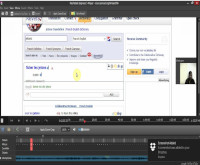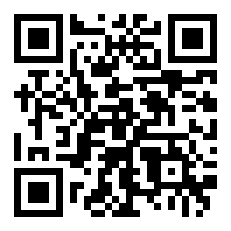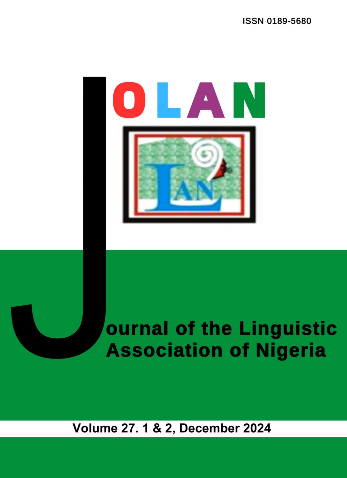Observing trainee-translators’ user activities with screen recorder: A process-oriented approach
Keywords:
external resources, total task time, screen recorders, user activitiesAbstract
Translation Process Research (TPR) primarily adopts different approaches to monitor how translators perform their tasks (Jakobsen & Jensen, 2008) with a view to identifying techniques and procedures for good quality translation (Lörscher, 2016, 601). In sub-Saharan Africa, studies that investigate translation processes are scarce. This article, therefore, discusses an empirical study conducted, using the Blueberry FlashBack screen-recording software to observe the processes of source text comprehension and translation by third-year students of French in South African. Analyses of the subjects’ user activity data indicated how screen-recording software revealed both the time each task’s segment was performed and how many times online dictionaries were consulted. Findings suggest among others, that the total time spent in performing a task is a product of how many times online dictionaries were consulted. Since translation studies are primarily focused on products (target texts), it is recommended that more attention be paid to process studies.
References
Angelone, E. (2010). Uncertainty, uncertainty management and metacognitive problem solving in the translation task. In G. M. Shreve, & E. Angelone (Eds.), Translation and Cognition (pp. 18-40). John Benjamins.
Angelone, E. (2020). The impact of screen recording as a diagnostic process protocol on inter-rater consistency in translation assessment. Journal of Specialised Translation, 34, 32-50.
Alves, F. (2015). Translation process research at the interface: Paradigmatic, theoretical, and methodological issues in dialogue with cognitive science, expertise studies, and psycholinguistics. In A. Ferreira & J.W. Schwieter (Eds.), Psycholinguistics and cognitive inquiries into translation and interpreting (pp. 17-40).
John Benjamins. Baker, M. (1993). Corpus linguistics and translation studies : Implications and applications. In M. Baker, G. Francis, & E. Tognini-Bonelli (Eds.), Text and technology : In honour of John Sinclair (pp. 233-250). John Benjamins.
Bassnett, S. & Lefevere, A. (1992). General editors’ preface. In A. Lefevere (Ed.), Translation/history/culture: a sourcebook (pp. xi-xii). Routledge.
Carl, M., Gutermuth, S. & Hansen-Schirra, S. (2015). Post-editing machine translation efficiency: Efficiency, strategies, and revision processes in professional translation settings. In A. Ferreira & J.W. Schwieter (Eds.), Psycholinguistics and cognitive inquiries into translation and interpreting (pp.145-174).
John Benjamins. Carl, M., Tonge, A., & Lacruz, I. (2019). A systems theory perspective on the translation process. Translation, Cognition and Behavior, 2(2), 211-232.
Dunne, K. J. (2014). Localization and the (R)evolution of Translation. In S. Bermann & C. Porter (Eds.), A Companion to Translation Studies (pp. 147–162). Wiley- Blackwell.
Ehrensberger-Dow, M., & Massey, G. (2013). Indicators of translation competence: Translators’ self-concepts and the translation of titles. Journal of Writing Research, 5(1), 103-131.
Gentzler, E. (2014). Translation studies: Pre-discipline, discipline, interdiscipline, and post-discipline. International Journal of Society, Culture & Language, 2(2), 13-24.
Gile, D. (2015). Analyzing Translation Studies with scientometric data: from CIRIN to citation analysis. Perspectives: Studies in Translatology, 23(2), 1-9.
Hatim, B. & Mason, I. (1997). The translator as communicator. Routledge.
Heibert, E. H. & Raphael, T. E. (1996). Psychological perspectives on literacy and extensions to educational practice. In David C. Berliner, Robert C. Calfee (Eds.), Handbook of Educational Psychology (pp. 550-602). Lawrence Erlbaum.
Holmes, J. S. (2000). The name and nature of Translation Studies. In L. Venuti (Ed.), The Translation Studies Reader (pp. 172-185). Rutledge.
Hurtado Albir, A., Alves, F., Englund Dimitrova, B., & Lacruz, I. (2015). A retrospective and prospective view of translation research from an empirical, experimental, and cognitive perspective: The TREC (Translation, Research, Empiricism, Cognition) network. The International Journal for Translation & Interpreting Research, 7(1), 5-25. ISO (International Standard Organisation). (2012). Quality Management Principles. A publication of the International Standard Organisation http://www.iso.org/iso/qmp_2012.pdf
Jakobsen, A. L. (2014). The development and current state of translation process research. In Elke Brems, Reine Meylaerts and Luc van Doorslaer (Eds.), The known unknowns of translation studies (pp. 65-88). John Benjamins.
Jakobsen, A. L., Jensen K. T. H. (2008). Eye movement behaviour across four different types of reading task. In S. Göpferich, A. L. Jakobsen & I. M. Mees (Eds.), Looking at eyes:Eye-tracking studies of reading and translation processing (pp. 103-124). Copenhagen Studies in Language 36 - Samfundslitteratur.
Jakobson, R. 2012. On linguistic aspects of translation. In L. Venuti (Ed.), The Translation Studies reader (pp. 126-131). Routledge.
Jungwha, C. (2003). The interpretive theory of translation and its current applications. Interpretation Studies, 3 (December), 1-15. www.jstage.jst.go.jp/article/istk/3/0/3_0301/_pdf
Kiraly, D.C. (1995). Pathways to translation: pedagogy and process. Kent State University Press.
Lambert, L. (2013). Prelude: The institutionalization of the discipline. In C. Millán & F. Bartrina (Eds.), The Routledge handbook of translation Studies(pp. 7-27). Routledge.
Lauffer, S. (2002). The translation process: An analysis of observational methodology. Cadernos de Tradução, 2(10), 59-74.
Lemaire, C. (2018). Traductologie et traduction outillée : du traducteur spécialisé professionnel à l’expert métier en entreprise (Issue of June 2017). Université Grenoble Alpes. https://theses.hal.science/tel-01683768v2/document
Lörscher, W. (2016). The translation process: Methods and problems of its investigation. Meta : Journal Des Traducteurs (Translators’ Journal), 50 (2), 597-608.
Massey, G. & Ehrensberger-Dow, M. (2011). Commenting on translation: implications for translator training. The Journal of Specialised Translation, 5, 26-41.
Mombe, M. N. (2019). Practicum: A missing link in the translator training at the postgraduate level in Nigeria. International Journal of Arts and Humanities, 8 (1), 65-75.
Mounin, G. (1963). Les problèmes théoriques de la traduction. Gallimard.
Munday, J. (2009). Issues in translation studies. In J. Munday (Ed.), The Routledge Companion to Translation Studies (pp. 1-19). Routledge.
Munday, J. (2012). Introducing Translation Studies: Theories and applications. Routledge.
Munday, J. (2016). Introducing translation studies: Theories and applications Routledge Taylor and Francis Group.
Ning, W. & Domínguez, C. (2016). Comparative literature and translation A cross- cultural and interdisciplinary perspective. In Y. Gambier & L. van Doorslaer (Eds.), Border crossings: Translation studies and other disciplines (pp. 287-308).
John Benjamins. Nwachukwu, J. F. (2017). Identifying and improvin reading comprehension in the translation process: A visualisation approach. Stellenbosch University. https://scholar.sun.ac.za/server/api/core/bitstreams/505b27d8-ae1f-41f8-9ed6-eedad9456111/content
Olvera-Lobo, M.D. & Gutiérrez-Artacho, J. (2017). Training versus profession: from translation to web localization. Proceedings of INTED2017
Conference [Online]. http://digibug.ugr.es/bitstream/10481/45688/1/1274.pdf
Orrego-Carmona, D., Dutka, Ł., & Szarkowska, A. (2018). Using translation process research to explore the creation of subtitles: An eye-tracking study. Journal of Specialised Translation, 30, 150–180.
Pym, A. (2003). Redefining translation competence in an electronic age: In defence of a minimalist approach. Meta: Translators’ Journal, 48(4), 481-497.
Pym, A. (2016). Translation Solutions for Many Languages. Bloomsbury Publishing.
Rabadán, R. (2008). Refining the idea of “applied extensions. In A. Pym, M. Shlesinge, & D. Simeoni (Eds.), Beyond descriptive translation studies: Investigations in homage to Gideon Toury (pp. 103-117).
John Benjamins. Study Corgi. (2021). The History of Translation Through the 20th Century (September 17). https://studycorgi.com/the-history-of-translation-through-the-20th-century/
Suzani, S. M., & Khoub, V. M. (2019). A study of Nida’s (1964) Types of equivalence in three English translations of letters 40 to 60 of Nahj-al-balagha. Science Arena Publications: Specialty Journal of Language Studies and Literature, 3(4), 34-43.
Toury, G. (2012). Descriptive translation studies and beyond.
John Benjamins. Vanroy, B., Schaeffer, M., & Macken, L. (2021). Comparing the effect of product-based metrics on the translation process. Frontiers in Psychology, 12, 1-16.
Venuti, L. (2021). The translation studies reader. Routledge.

Downloads
Published
How to Cite
Issue
Section
License

This work is licensed under a Creative Commons Attribution-NonCommercial-ShareAlike 4.0 International License.













